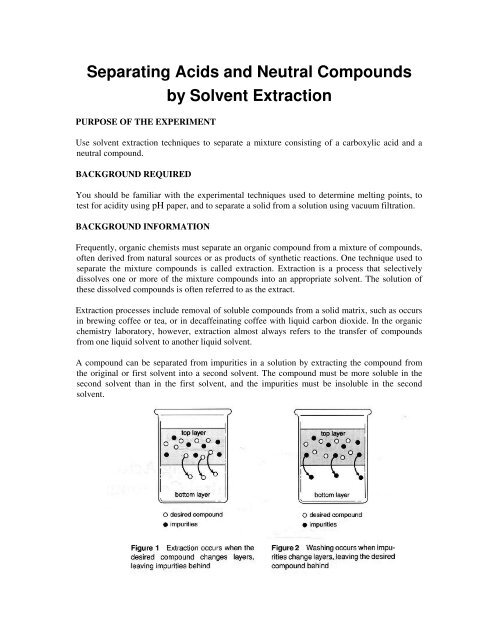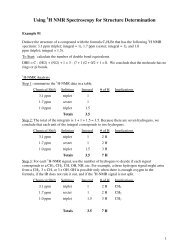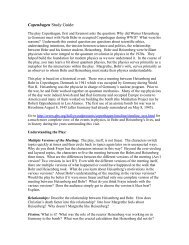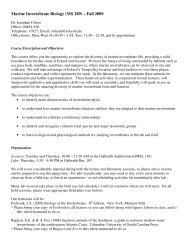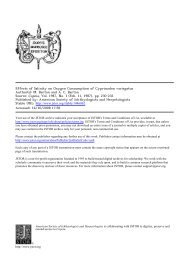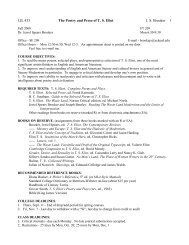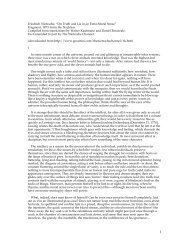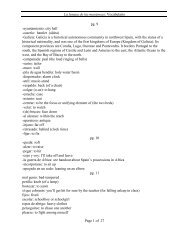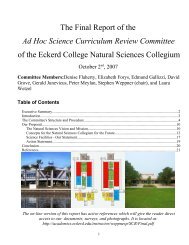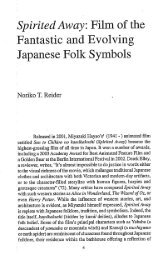Separating Acids and Neutral Compounds by Solvent Extraction
Separating Acids and Neutral Compounds by Solvent Extraction
Separating Acids and Neutral Compounds by Solvent Extraction
Create successful ePaper yourself
Turn your PDF publications into a flip-book with our unique Google optimized e-Paper software.
<strong>Separating</strong> <strong>Acids</strong> <strong>and</strong> <strong>Neutral</strong> <strong>Compounds</strong><br />
PURPOSE OF THE EXPERIMENT<br />
<strong>by</strong> <strong>Solvent</strong> <strong>Extraction</strong><br />
Use solvent extraction techniques to separate a mixture consisting of a carboxylic acid <strong>and</strong> a<br />
neutral compound.<br />
BACKGROUND REQUIRED<br />
You should be familiar with the experimental techniques used to determine melting points, to<br />
test for acidity using pH paper, <strong>and</strong> to separate a solid from a solution using vacuum filtration.<br />
BACKGROUND INFORMATION<br />
Frequently, organic chemists must separate an organic compound from a mixture of compounds,<br />
often derived from natural sources or as products of synthetic reactions. One technique used to<br />
separate the mixture compounds is called extraction. <strong>Extraction</strong> is a process that selectively<br />
dissolves one or more of the mixture compounds into an appropriate solvent. The solution of<br />
these dissolved compounds is often referred to as the extract.<br />
<strong>Extraction</strong> processes include removal of soluble compounds from a solid matrix, such as occurs<br />
in brewing coffee or tea, or in decaffeinating coffee with liquid carbon dioxide. In the organic<br />
chemistry laboratory, however, extraction almost always refers to the transfer of compounds<br />
from one liquid solvent to another liquid solvent.<br />
A compound can be separated from impurities in a solution <strong>by</strong> extracting the compound from<br />
the original or first solvent into a second solvent. The compound must be more soluble in the<br />
second solvent than in the first solvent, <strong>and</strong> the impurities must be insoluble in the second<br />
solvent.
Also, to effect the extraction, the two solvents selected<br />
must be immiscible, or not soluble in one another, so<br />
that they produce two separate solvent layers. After<br />
dissolving the mixture in the first solvent, the solution<br />
is added to the second solvent. The two layers are<br />
vigorously mixed to maximize the surface area between<br />
them. This mixing facilitates the transfer of a dissolved<br />
compound from one layer to another. Once the transfer<br />
process is complete, the layers are again allowed to<br />
form, as shown in Figure 1. Separation of the two<br />
layers then completes the separation of the desired<br />
compound from the impurities.<br />
Washing is the reverse process, in which the impurities<br />
are removed to the second solvent, leaving the desired<br />
compound in the original solvent, as shown in Figure 2.<br />
The amount of compound to be extracted determines<br />
whether macroscale or microscale techniques should be<br />
employed for the extraction. The chemical principles<br />
associated with the extractions are identical, but the<br />
techniques are somewhat different.<br />
<strong>Extraction</strong>s using larger quantities of solvents, tens or<br />
hundreds of milliliters, require a separatory funnel, as<br />
shown in Figure 3. The solvent layers are mixed <strong>by</strong><br />
shaking the separatory funnel. Then the layers are<br />
allowed to reform. The bottom layer is drained through<br />
the stopcock; the top layer is poured from the top of the<br />
separatory funnel.<br />
Microscale extractions can be conducted using a test<br />
tube or a centrifuge tube. Mixing <strong>and</strong> separating the<br />
layers can be done using a Pasteur pipette. In this<br />
experiment, we will be performing a macroscale<br />
extraction; about one gram of a mixture (of two<br />
compounds) will be separated into two samples.<br />
Choosing a solvent<br />
The first requirement in the extraction process is to<br />
select two immiscible solvents. One solvent, usually<br />
water, should be polar in nature. The second solvent<br />
should be nonpolar <strong>and</strong> might be a hydrocarbon, an<br />
ether, or a chlorinated solvent, such as<br />
dichloromethane. When the two immiscible solvents<br />
are placed into a container, two liquid layers result. The<br />
more dense solvent is always the bottom layer.
It is important to identify the solvent in each layer. Hydrocarbons <strong>and</strong> ethers are less dense than<br />
water or the dilute aqueous solutions used in extractions. When one of these nonpolar solvents<br />
is used, the water layer is the bottom layer, as shown in Figure 4.<br />
However, dichloromethane is more dense than water. When dichloromethane is used as the<br />
nonpolar solvent, the water layer will be the top layer, as shown in Figure 5.<br />
Although the identity of each layer can be established from the density of each solvent, their<br />
identities should be confirmed. To confirm the identities of the layers, one or two drops of water<br />
are introduced just below the surface of the top layer. If the drops of water mix with the top<br />
layer, then the top layer is the water layer. If the drops of water fall through the top layer to the<br />
layer below, then the water layer is the bottom one. It is a good practice to save all layers in<br />
labeled containers until the experiment is complete <strong>and</strong> the desired product is isolated.<br />
Often the two solvents will not completely separate after shaking, due to the formation of an<br />
emulsion at the interface between them. An emulsion is a suspension of small droplets of one<br />
liquid in another liquid. (A familiar example of an emulsion is oil <strong>and</strong> vinegar, after shaking).<br />
Emulsions are generally opaque or cloudy in appearance <strong>and</strong> are often mistaken as a third layer.<br />
The small size of the droplets in an emulsion causes the separation of the two solvents to take<br />
place very slowly. Several procedures may be helpful to facilitate this separation. For example,<br />
gentle swirling of the container, addition of a few drops of saturated aqueous sodium chloride<br />
(NaCl) or ethanol, or addition of more solvent to dilute the solutions may help. In particularly<br />
difficult cases, it may be necessary to filter the mixture to remove small solid particles that<br />
promote emulsion formation.<br />
A simple, but useful, guide to solubility is like dissolves like. That is, nonpolar compounds,<br />
including most organic compounds, are more soluble in nonpolar solvents than in polar<br />
solvents. On the other h<strong>and</strong>, ionic <strong>and</strong> polar compounds are more soluble in polar solvents, such<br />
as water. These solubility differences can be exploited to separate nonpolar compounds from<br />
ionic or polar compounds.<br />
For example, synthetic reactions often produce ionic, inorganic salts as <strong>by</strong>-products of the<br />
desired nonpolar organic product. In such cases, these salts are removed <strong>by</strong> washing the<br />
nonpolar solvent with water. The organic compound remains dissolved in the nonpolar solvent.<br />
Some organic compounds are sufficiently polar to be quite soluble in water. <strong>Extraction</strong> of such<br />
polar compounds into a nonpolar solvent is often difficult. The process can be facilitated <strong>by</strong><br />
using the technique called salting out. Inorganic salts, such as NaCl, are dissolved in water to<br />
reduce the solubility of the organic compound in the aqueous layer. Under these conditions, the<br />
organic compound preferentially dissolves in the nonpolar layer.<br />
<strong>Extraction</strong> is a particularly effective means of separating organic compounds if one compound<br />
in the mixture can be chemically converted to an ionic form. The ionic form is soluble in an<br />
aqueous layer <strong>and</strong> can be extracted into it. Other non-ionized organic compounds in the mixture<br />
will remain dissolved in the nonpolar solvent layer. Separation of the two layers results in the<br />
separation of the dissolved compounds. This is the approach that will be used to separate<br />
compounds in this experiment.
Ionic forms of some organic compounds can be produced <strong>by</strong> reacting them with aqueous acids<br />
or bases (see Figure 6). Reacting organic acids with bases such as sodium hydroxide (NaOH)<br />
converts these acids to water-soluble anions. Reacting basic amines with dilute aqueous acid<br />
solutions such as hydrochloric acid (HCl) converts the amines to water-soluble cations.<br />
We will separate a mixture of acetanilide (a weak base) from p-toluic acid (a weak acid). These<br />
two compounds have similar polarities (<strong>and</strong> therefore have similar solubility properties); they<br />
are essentially insoluble in highly polar solvents such as water, but very soluble in solvents with<br />
moderate polarity such as ethers or ketones. So, if placed into a separatory funnel with both an<br />
organic solvent <strong>and</strong> water, both compounds will dissolve in the organic layer.<br />
In order to separate these compounds, we will convert the water insoluble acid into a water<br />
soluble salt:<br />
O OH<br />
CH 3<br />
+<br />
Na OH<br />
O O - Na +<br />
Figure 6: Acidic organic compounds can be converted to water<br />
soluble forms <strong>by</strong> reaction with aqueous base<br />
Because an ionic compound is formed in this reaction, the product is very soluble in water, but<br />
not soluble in ether. So this product (called sodium p-toluate) will extract into the aqueous<br />
layer.<br />
The other compound, acetanilide, does not react with NaOH <strong>and</strong> remains dissolved in the<br />
relatively nonpolar ether. The separatory funnel can be used to separate the aqueous layer<br />
(containing the sodium p-toluate) from the organic layer (containing the acetanilide). This is<br />
how the compounds are separated; the remainder of the experiment consists of recovering the<br />
two compounds in their pure (solid) form.<br />
To recover acetanilide, you will dry the nonpolar layer with anhydrous sodium sulfate (Na2SO4)<br />
<strong>and</strong> evaporate the solvent under vacuum. As the solvent evaporates, the acetanilide will remain.<br />
To recrystallize the p-toluic acid from the aqueous layer, we simply have to reverse the reaction<br />
above. By adding some strong acid to the aqueous layer, the NaOH is neutralized, <strong>and</strong> the ionic<br />
salt is converted back into p-toluic acid. (Note that this is simply the reverse of the reaction<br />
shown above – the salt is converted back into the acid, forming NaCl as a <strong>by</strong>-product). Because<br />
p-toluic acid is NOT very water soluble, it will crystallize from the water as it is formed.<br />
After you dry the compounds, you will measure the mass of each isolated compound. Finally,<br />
you will measure the melting point of the acetanilide <strong>and</strong> assess its purity <strong>by</strong> comparing the<br />
experimentally measured melting point with the literature value.<br />
CH 3<br />
+ O<br />
H 2
Figure 7: A flowchart summarizing the steps of extraction for this experiment
PROCEDURE<br />
Reagents <strong>and</strong> <strong>Solvent</strong>s<br />
Acetanilide/p-Toluic Acid mixture diethyl ether<br />
3M hydrochloric acid 0.5M sodium hydroxide<br />
sodium sulfate, anhydrous water, distilled or deionized<br />
Preview<br />
• Dissolve acetanilide <strong>and</strong> p-toluic acid in ether (See Figure 7)<br />
• Extract p-toluic acid from the ether layer with NaOH solution, separating the layers<br />
• Isolate p-toluic acid <strong>by</strong> adding HCI solution to the aqueous NaOH layer<br />
• Isolate acetanilide <strong>by</strong> drying the ether solution, then evaporating ether<br />
• Dry the isolated compounds <strong>and</strong> measure their masses<br />
• Measure the melting point of the acetanilide sample <strong>and</strong> compare to literature value<br />
PROCEDURE<br />
Chemical Alert<br />
acetanilide—toxic <strong>and</strong> irritant<br />
anhydrous sodium sulfate—irritant <strong>and</strong> hygroscopic<br />
diethyl ether—flammable <strong>and</strong> irritant<br />
3M hydrochloric acid—toxic <strong>and</strong> corrosive<br />
0.5M sodium hydroxide—toxic<br />
Caution: Wear departmentally approved safety goggles at all times while in the chemistry<br />
laboratory.<br />
1. Preparing the <strong>Extraction</strong> Mixture<br />
NOTE 1: Be sure to close the stopcock at the bottom of the separatory funnel before adding<br />
solutions.<br />
Caution: Acetanilide is toxic <strong>and</strong> irritating. Diethyl ether is flammable <strong>and</strong> irritating.<br />
Keep away from flames or other heat sources. Prevent eye, skin, <strong>and</strong> clothing contact<br />
with these compounds. Avoid inhaling vapors or dust or ingesting these compounds.<br />
Weigh 0.25—0.35 g of acetanilide <strong>and</strong> 0.4—0.6 g p-toluic acid. Record the exact mass of each<br />
compound. Place 25 mL of diethyl ether into a 100-mL beaker. Add the two solids to the diethyl<br />
ether <strong>and</strong> mix to dissolve. Pour this solution into a 125-mL separatory funnel supported <strong>by</strong> an<br />
iron ring, as shown in Figure 3.<br />
NOTE 2: the solids may take 5 minutes or more to dissolve. You should stir the mixture during<br />
this time. Because agitation (<strong>by</strong> stirring) greatly increases the evaporation rate of the ether, this<br />
step should be performed in the hood, or you can perform this step at your desk if you keep the<br />
beaker covered with a watch glass. This will minimize the ether fumes in the lab.
2. Extracting p-Toluic Acid<br />
NOTE 3: If you open the stopcock while the glass stopper is in the top of the separatory funnel,<br />
a slight vacuum will be created, <strong>and</strong> the bottom layer will not drain from the funnel.<br />
Add 10 mL of 0.5M aqueous NaOH to the ether<br />
solution in the separatory funnel. Place the glass<br />
stopper in the top of the separatory funnel, <strong>and</strong><br />
invert the funnel while holding the stopper in<br />
place, as shown in Figure 8. Gently mix the two<br />
layers <strong>by</strong> rocking the separatory funnel back <strong>and</strong><br />
forth. With the funnel inverted, open the stopcock<br />
to vent any gas that is generated. Listen for the gas<br />
as it exits through the stopcock. Continue this<br />
mixing process, gradually increasing the force of<br />
the mixing. Remember to vent the funnel<br />
frequently! You should always vent the funnel<br />
after about 30 – 40 seconds of mixing.<br />
The addition of the aqueous NaOH will create a<br />
second, immiscible layer in your separatory<br />
funnel. Confirm the identity of the layers <strong>by</strong> using<br />
a Pasteur pipette to introduce one or two drops of<br />
water just below the surface of the top layer.<br />
Make certain no air is in the pipette tip. Closely<br />
observe what happens to the drops. How can you tell which layer is water, <strong>and</strong> which one is<br />
ether?<br />
Remove the glass stopper from the top of the funnel, <strong>and</strong> open the stopcock to allow the aqueous<br />
layer to drain into a clean, labeled 100-mL beaker. [NOTE 2] When the interface between the<br />
layers just reaches the bottom of the funnel (top of the stopcock), close the stopcock to retain<br />
the ether layer in the funnel.<br />
Add a second 10-mL NaOH portion to the funnel to remove any p-toluic acid remaining in the<br />
ether layer. Mix with frequent venting. After the layers have separated, drain the aqueous layer<br />
into the beaker with the first extract. Repeat with a third 10-mL NaOH portion.<br />
Add 5 mL of distilled or deionized water to the separatory funnel <strong>and</strong> mix. Drain the water layer<br />
into the beaker containing the three NaOH solution extracts.<br />
3. Isolating p-Toluic Acid<br />
Caution: 3M Hydrochloric acid (HCl) is toxic <strong>and</strong> corrosive. Prevent eye, skin, <strong>and</strong> clothing<br />
contact. Avoid inhaling the vapors or ingesting HCl.<br />
To precipitate the p-toluic acid, carefully add 3M HCl to the NaOH solution extracted in part 2.<br />
As soon as the solution becomes acidic, a precipitate of p-toluic acid will begin to form. (The<br />
water soluble salt is converted to a water insoluble acid in an acidic solution). You should be<br />
able to calculate how many mL of 3.0 M HCl is required to neutralize the 30. mL of<br />
0.5 M NaOH that you added.
To test for acidity, remove a drop of the solution with a stirring rod <strong>and</strong> place the drop on a<br />
small piece of pH test paper. Continue to add the 3M HCl, dropwise with stirring, until no more<br />
solid is produced <strong>and</strong> the solution tests moderately acidic (approximately pH 3).<br />
Weigh a filter paper <strong>and</strong> record its mass. Using the weighed filter paper, separate the crystals<br />
from the solution using vacuum filtration with a Büchner funnel. Support the crystals <strong>and</strong> paper<br />
on a watch glass <strong>and</strong> allow the crystals to air dry.<br />
4. Isolating Acetanilide<br />
Caution: Anhydrous sodium sulfate (Na2SO4) is irritating <strong>and</strong> hygroscopic. Prevent eye,<br />
skin, <strong>and</strong> clothing contact.<br />
Select the separatory funnel containing the ether layer from Part 2. Drain the ether solution into<br />
a small Erlenmeyer flask <strong>and</strong> add approximately 1 g of anhydrous Na2SO4 to the flask to remove<br />
any traces of water from the solution. (If the solvent contains water, it will not evaporate<br />
completely in the next step). Stopper the flask <strong>and</strong> allow it to st<strong>and</strong> for 5 min with occasional<br />
swirling. (NOTE 3).<br />
NOTE 4: After anhydrous Na2SO4 absorbs water, it will look like salt or sugar.<br />
Decant the ether/acetanilide solution from the Erlenmeyer flask into a clean, dry, pre-weighed<br />
round-bottom flask. To remove the ether solvent <strong>and</strong> recover the acetanilide crystals, we will<br />
take advantage of the fact that a solvent’s boiling point decreases as the atmospheric pressure<br />
decreases. By lowering the pressure above the solution, we can boil the ether away at room<br />
temperature, or <strong>by</strong> warming it slightly. (This is MUCH SAFER than applying heat, because<br />
ether is extremely flammable, <strong>and</strong> has a low flash point!).<br />
Under the supervision of your lab instructor or T.A., connect the round-bottom flask to the<br />
Roto-Vap <strong>and</strong> apply vacuum. Lower the round-bottom into the warm water bath <strong>and</strong> turn on the<br />
motor to begin rotating the flask. The ether will begin boiling within a minute; all of the ether<br />
should evaporate within about 3 - 5 minutes. After all of the liquid is gone <strong>and</strong> the crystals<br />
appear dry, continue heating the sample for an additional minute to ensure complete evaporation<br />
of the ether.<br />
5. Measuring Product Mass <strong>and</strong> Melting Point<br />
NOTE 5: If possible, the sample of p-toluic acid should be dried in an oven for 10 minutes to<br />
completely evaporate the water. Consult your instructor to find out how you should dry your<br />
p-toluic acid sample.<br />
When all of the samples are dry measure the mass of each compound. Measure the melting<br />
point of each compound, <strong>and</strong> assess its purity <strong>by</strong> comparing the measured melting point with the<br />
literature value.<br />
NOTE 6: Your thermometer may only record temperatures up to 150° C; if this is the case, you<br />
will not be able to record the m.p. of p-toluic acid, which has a literature m.p. value of<br />
180° - 181°C!
6. Cleaning Up<br />
Use the waste collection containers, provided <strong>by</strong> your laboratory instructor. If you used the<br />
vacuum method to remove the ether from the acetanilide (step 4a), then the ether from your trap<br />
should be disposed of in the organic solvent waste container. There will be a separate container<br />
for the solids. The aqueous layer (from which the p-toluic acid was recovered, in part 3) can be<br />
disposed of in the sink, diluting with a large amount of running water. Clean your glassware<br />
with soap or detergent.<br />
Caution: Wash your h<strong>and</strong>s thoroughly with soap or detergent before leaving the laboratory!<br />
(You always do that anyway, don’t you?)<br />
POST-LABORATORY QUESTIONS<br />
1. Based on the amounts of p-toluic acid <strong>and</strong> acetanilide you recovered, estimate the<br />
composition of the original mixture.<br />
2. What product would you obtain if you evaporated the water from the NaOH layer prior to<br />
acidifying the layer?<br />
3. Suppose that you used dichloromethane instead of diethyl ether as the nonpolar solvent in<br />
this experiment. What changes in the procedure would you make in view of the fact that<br />
dichloromethane is more dense than water?<br />
4. Benzoic acid (C6H5—COOH) is a weak acid <strong>and</strong> naphthalene is neutral, neither acidic or<br />
basic. Prepare a flowchart for the separation <strong>and</strong> recovery of benzoic acid <strong>and</strong><br />
naphthalene.<br />
O OH<br />
Benzoic Acid Naphthalene<br />
solubility in water: poor solubility in water: poor<br />
solubility in ether: good solubility in ether: good<br />
5. After comparing the melting points of each of your compounds to their respective<br />
literature values, comment on the purity of each compound.
Pre-Laboratory Assignment <strong>Solvent</strong> <strong>Extraction</strong><br />
Name __________________________________________ Date __________<br />
1. Briefly describe the hazards you should be aware of when you work with:<br />
(a) diethyl ether<br />
(b) 3M HCl<br />
2. Briefly explain or describe the following:<br />
(a) How would you determine which layer is the aqueous layer after you add NaOH solution to<br />
the ether solution of your compounds?<br />
(c) What visible evidence(s) of reaction will you see when you acidify the NaOH extract with<br />
HCl solution?<br />
(d) In which layer would p-toluic acid be more soluble if p-toluic acid were added to a two-layer<br />
mixture of diethyl ether <strong>and</strong> water?
<strong>Solvent</strong> <strong>Extraction</strong>, Pre-lab page 2<br />
(e) How would the results differ if you added sodium p-toluate instead of p-toluic acid to the<br />
two-layer mixture of diethyl ether <strong>and</strong> water?<br />
4. How many milliliters of 3.0 M HCl would be required to neutralize 30. mL of 0.50 M<br />
NaOH? (Show your work).<br />
5. Briefly explain how you will isolate p-toluic acid after it is extracted it into NaOH solution.<br />
6. Write the equation for the chemical reaction of the toluate ion that will occur when you<br />
add HCl solution to the NaOH extract in part 3.


